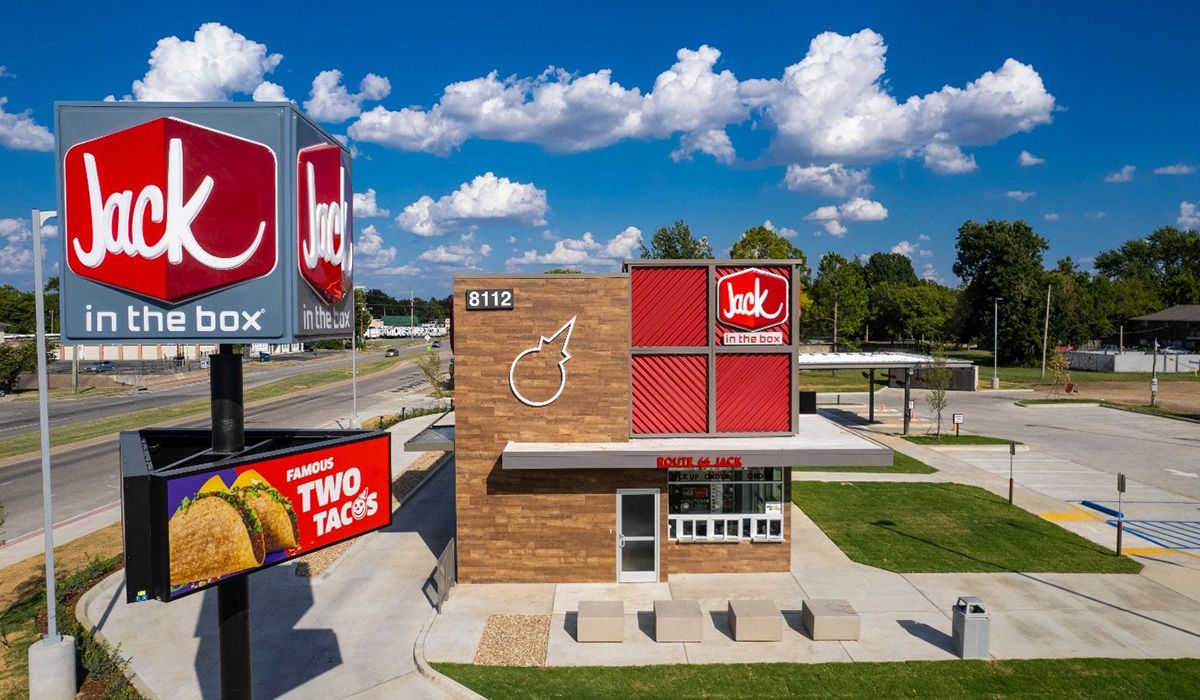With Jack in the Box being the fifth-biggest quick-service burger chain in the U.S. and Del Taco positioned as the second-largest Mexican brand in the space, CEO Darin Harris honestly can’t think of any other chains that have that type of scale and proof of concept, yet still maintain “such tremendous whitespace across the United States for growth.”
“Now this takes time,” Harris said during Jack’s Investor Day on Wednesday. “In the last three years, we’ve been preparing for this growth.”
Previously, Jack averaged negative 2 percent comps from 2013 to 2020, had fewer than 1 percent digital sales, and suffered from strained franchisee relationships. CEO Darin Harris entered the fold in June 2020 and brought with him a new roadmap for expansion. He settled a lawsuit with the franchisee association and kicked off a development initiative that’s still going strong.
Jack has roughly 2,200 units in 23 states, and since 2021, it has signed 90 development agreements for a total of 389 restaurant commitments. Before 2021, the company’s pipeline had no concrete timeline for opening. Now, those hundreds of commitments are on a specific schedule to debut between 2024 and 2027.
The chain is 93 percent franchised and handled by well-capitalized operators that own an average of 20 stores. Between fiscal years 2020 and 2023, the brand averaged 5 percent same-store sales growth, increased its AUV from $1.7 million to $2 million, and lifted digital mix from 4 percent to 12 percent. In 2023, Jack experienced positive net unit growth for the first time in five years and welcomed its first new market openings in over a decade in Salt Lake City and Louisville. Existing restaurants matter, too. Historically, Jack has earned 16 percent same-store sales growth on its remodels.
“I believe franchisees share in our ambition, and they’re partners in strategy,” Harris said. “This is a very important point in our story. Having a relationship with our franchisees where we are partners in strategy, we have the ability to assist each other to provide better service to our guests, to share information on how we drive both our top line and bottom line performance, is critical to our business. And these relationships have to be built on trust because these best practices are shared amongst each other to get feedback from our franchisees, and then we share them across the community. So I’m pleased that this is a core part of our company culture.”
READ MORE: Why Customers Love Jack in the Box’s New Smashed Jack
In 2024 and beyond, Jack hopes leveraging high sales, improving restaurant-level economics, and strengthening development capabilities will drive 2.5 percent net unit growth, a $2.5 million AUV, a 20 percent digital sales mix and $1 billion on a dollar basis, a 15 percent four-wall franchise EBITDA, and less than a five-year payback. Helping Jack reach further scale is Del Taco, which it acquired for nearly $600 million in 2021. The brand is in the process of refranchising many of its corporate units, including offering spots to eager Jack franchisees.
Jack believes it has room for 5,750 restaurants in the U.S. As of now, new market openings are being planned in Montana, Wyoming, Arkansas, and South Florida. Del Taco has 600 stores, but has space for about 2,600 units. It plans to break into Montana, Wyoming, Virginia, Texas, and North Carolina. Despite Jack not being in every state, it has an average brand awareness of 87 percent in whitespace markets and 95 percent in current DMAs.
Jack expects 35-55 gross openings in fiscal 2024 for both brands combined. That should increase to 55-85 units in 2025, 70-100 in 2026, and 90-120 in 2027. Each chain works with three prototypes—drive-thru only, a 2,300-square-foot building, and a 2,000-square-foot edition.
Growth will be justified by continued customer loyalty. Jack owns 20 percent of its digital sales, up from 10 percent in Q4 2022. The goal is to boost that to more than 35 percent by further enhancing the app, expanding digital partnerships and payments, transforming the in-restaurant pickup experience, and expanding the loyalty program with personalization. Last year, Jack increased loyalty engagement by 40 percent and lifted mix to 2.8 percent. Del Taco, facing the same journey, grew engagement by 32 percent and increased loyalty mix to 5.9 percent.
For Jack and Del Taco, guest frequency will depend on convenience and less friction. The chains are testing kiosk ordering and implementing AI at the drive-thru. These are strategies that have helped Jack reduce speed of service from 5 minutes and 17 seconds in Q1 2022 to 4 minutes and 57 seconds in Q1 2024. There’s money to be made here; a 5-second improvement in speed translates to $8,000 worth of sales uplift.
“I believe we have a tremendous opportunity to grow these two challenger brands,” Harris said. “Combined we’re over 130 years of experience, we have over $6 billion in sales, and we have two exceptional business models and concepts. As challengers, we’re always looking for ways to be nimble or defy the status quo to achieve our objectives and drive performance. What I believe is unique about Jack in the Box and Del Taco, is we have a real growth opportunity within burger [quick service] and Mexican [quick service].”








